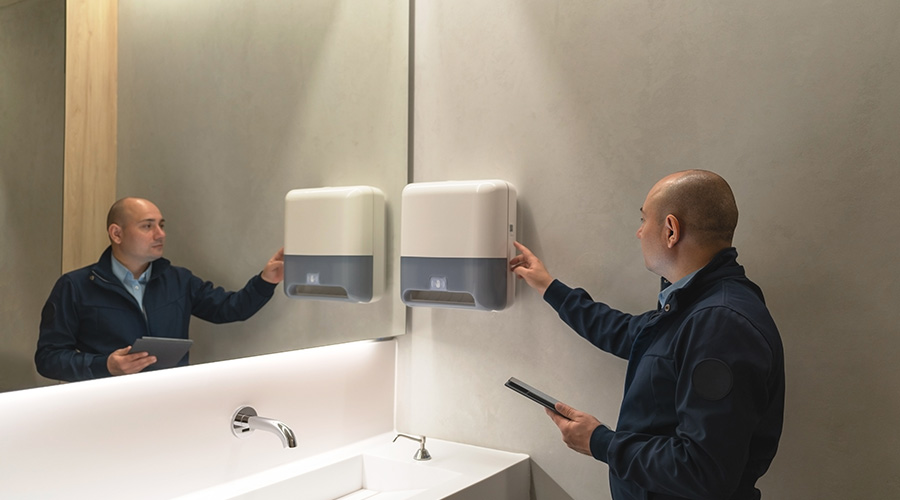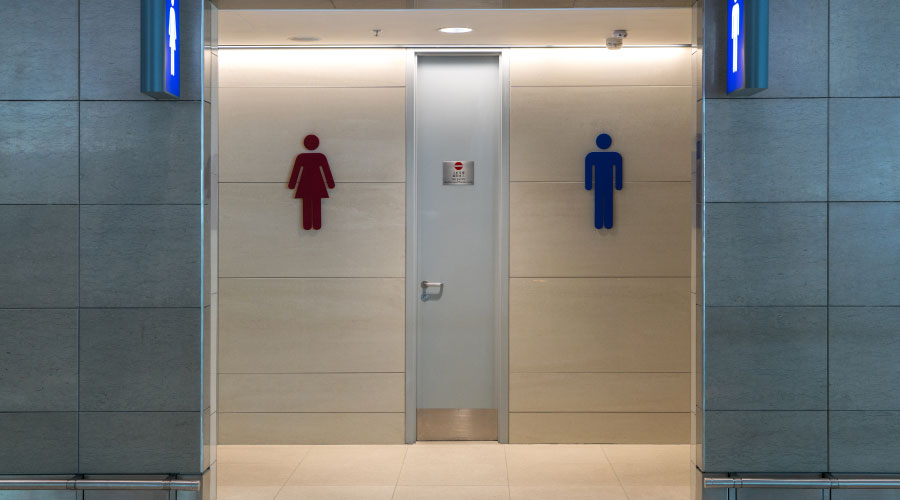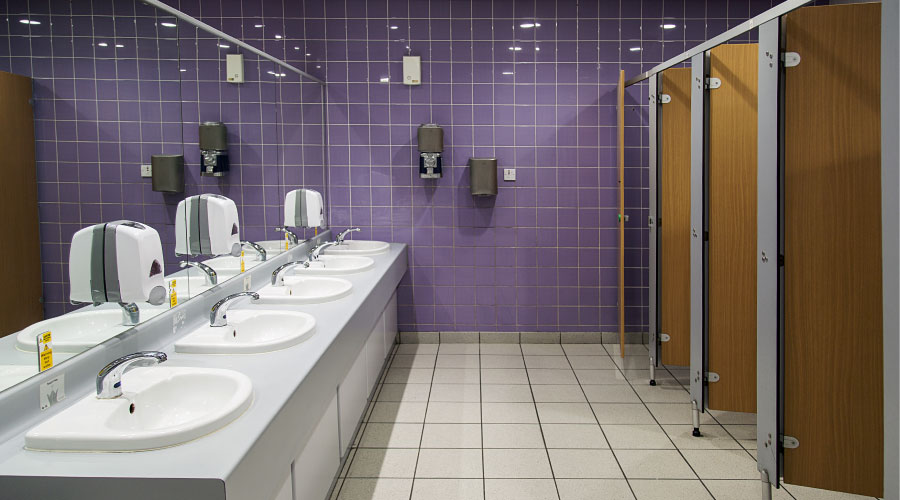Creating Healthy Plumbing Systems
Unique issues in health care facilities create challenges in maintaining systems and protecting patients
Plumbing systems in health care facilities present a host of challenges to front-line maintenance technicians. While some of these challenges are similar to those in other types of facilities, others are unique to the health care environment.
A review of the most common plumbing maintenance challenges can help managers develop strategies to meet these challenges as part of supporting the health care mission, and it can prepare them for emerging challenges related to facility design and operations that will affect the maintenance of plumbing components and systems.
Outlining Challenges
Typical plumbing concerns for all facilities include repairing toilet, sink and shower; maintaining piping systems throughout the facility for air, water, and gas; keeping drain systems and waste-water lines open and operating properly; and maintaining sprinkler systems, heads, valves, and other fire-safety equipment. Keeping up with new regulatory requirements, such as updates to the Americans with Disabilities Act (ADA) is also a concern.
Health care and non-health care facilities alike must address measures to conserve water. From both environmental and economic perspectives, it makes good sense to keep an eye on water consumption. An up-to-date and efficient plumbing system can help make conservation a reality.
On the other hand, it is well known that the sanitary requirements for hospital environments are much more demanding than those of most non-hospital environments. What is not as well known is that some hospital bacteria strains tend to be more resistant in both level and spectra to antibiotics and bacteriostatic and bactericidal concentrations of antiseptics and disinfectants.
Tests revealed in one instance that a hospital bacterial strain had a marked resistance to three to five drugs, while a form of the same bacteria found in non-hospital environments was resistant to only one or two drugs. In such cases, hospitals are challenged to specify and effectively use a range of more concentrated organic and non-organic cleaning chemicals, antiseptics and disinfectants than non-hospital environments, and they must use them more often.
Checking the Scope
In health care facilities, the number of plumbing fixtures and plumbing systems is much larger, as is the breadth of equipment types, including medical gas systems and piping for air, nitrous oxide, and oxygen, which must be available in emergency and operating areas, as well as patient rooms.
Hospitals’ special needs include operating a 24-hour-a-day, seven-day-a-week central processing department, where instruments and equipment first are washed in several washers and disinfectors, then sterilized in dozens or even hundreds of individual sterilizers.
Plumbing systems for this central processing must effectively handle water and steam used in the cart washers and instrument washer and disinfectors. They must also maintain the medical gas systems required for ethylene oxide or hydrogen peroxide used in the sterilizers.
An immense challenge for managers is to maintain the environment at a high level of cleanliness on surfaces, in potable water systems, and in the air. They also must minimize contact by patients, caregivers and visitors with the plumbing fixtures used by many occupants many times each day.
At the same time, custodial personnel and others must subject fixtures to strong concentration of chemicals, such as chlorine bleach and ammonia solutions, to maintain a sanitary environment. Fixtures must be corrosion-resistant to withstand these harsh chemicals and the abrasion of the cleaning process. Medical gas piping, valves and fittings also require special care to ensure the safety and health of patients.
A Closer Look
Among the areas factors that will affect managers’ strategies for plumbing system maintenance are the type, age, design and condition of systems and fixtures.
Types of fixtures. In the health care environment, these can include chromium surfaces for its high-corrosion resistance and ability to withstand repeated abrasion. The approved solutions in hospital plumbing fixture specifications include one- and two-lever or battery-operated sensor faucets and battery-operated sensor flush valves with manual push-button override.
Age and design. The age of fixtures and their design go hand in hand, since older fixtures do not have the flow characteristics of newer ones. For instance, older fixtures are likely to have higher flow rates while newer designs can save a great deal of water — as much as 50 percent, depending on age and design of the older fixtures.
Older fixtures also are more likely to cause splashing, which can result in wet floors and safety problems, particularly in patient areas where they present a slipping hazard for everyone, especially disabled patients. Newer faucets and flush valves tend to have better flow design, which, along with lower flow volumes, reduce splashing and increase safety.
Proper system design also is essential. Plumbing systems are susceptible to harsh or toxic chemicals entering the potable water system via cross-connection or backflow. Plumbing systems that have faucets with hose adapters or inlets below the water line must have properly designed check valves or vacuum breakers installed and working effectively. And faucet discharges in sinks should have enough clearance height between the faucet spout and the basin overflow so no contamination of utensils occurs.
Hoses that are connected to a screw-type sink fitting can be protected by a hose adapter vacuum breaker only for low-hazard materials. Atmospheric vacuum breakers can be used for high-hazard materials, but only if specific height and location requirements are met and the downstream outlets unobstructed.
Managers can specify reduced-pressure principle backflow preventers with upstream and downstream shutoffs and test fittings to protect potable water in continuous-pressure conditions and against high hazard contamination. Inspection should occur at least twice a year to ensure, among other things, that they meet lead-content codes.
Manufacturers must prepare piping, valves and fittings used in non-flammable medical gas systems as if they were to be used for oxygen. According to ANSI/NFPA code 99, manufacturers must thoroughly clean these products and remove all oil, grease, and other readily oxidizable material left over from manufacturing, as if the products were being prepared for oxygen service.
Before final assembly, technicians must carefully store and handle products, including capping or plugging openings, in order to prevent contamination after cleaning. They must be re-examined internally again just before final assembly.
Other code restrictions call for brazed joints to be made up using brazing filler metals that bond to the base metals being brazed. Copper-to-copper joints must be made using copper-phosphorus brazing filler metal and no flux. Threaded joints have to be tinned or sealed with Teflon-type tape on the male threads, or other oxygen-suitable sealant.
Condition. The overall condition of plumbing systems, or the level of maintenance, is an issue that is always present, even with new systems. Regular preventive inspection, is a necessary part of any plumbing system maintenance program. Predictive maintenance techniques, such as pump vibration analysis, can detect impending breakdowns and allow time for scheduled repair to avoid service interruptions.
Particularly in high-use areas, this step will ensure that all systems operate properly with minimum downtime for repair. Non-contact fixtures need battery and seal changes. All valves need adjustment, O-ring and packing replacement, gasket replacement, filter changes, and gate, globe and seat replacements from time to time to prevent leaks.
Backflow preventers, such as check valves and vacuum breakers, need periodic inspection and parts replacement to ensure a positive seal. Pipeline traps and strainers are subject to plugging and malfunction unless they are kept clean and clear and wearing parts are replaced in a timely fashion.
With the huge number and type of equipment items in a health care facility’s plumbing system, it is a challenge to ensure that everything is covered frequently enough and no surprises occur. This is where the maintenance history records are invaluable.
If each work order accurately and completely documents the work done and time spent, these records will show management exactly where the best opportunities for improvement lie. Managers also can run a pareto analysis of maintenance history to show, in descending order, which equipment items have required the most maintenance actions.
Typically, an 80/20 split occurs, meaning 80 percent of the cost is spent on 20 percent of the equipment items. Once managers sort out these high-cost items, they can perform a more detailed root-cause evaluation. A look at type, age, design and condition, as well as maintenance history, can reveal hidden opportunities for improvement.
These opportunities don’t necessarily mean huge capital outlays. First, managers might consider improving cleaning, adjusting, lubricating, and preventive maintenance work content or frequency, or scheduling minor upgrades of existing components. Over the longer range, managers can consider major capital expenditures, using the plumbing equipment history to evaluate return on the investment.
Emerging Issues
Several plumbing related issues seem certain to affect managers’ decisions on specifying plumbing products and performing system maintenance.
First, a multi-team, multi-factor approaches in Veterans Administration (VA) facilities has worked well to reduce incidents of multi-drug resistant tuberculosis below levels achieved in non-VA health care systems. Also, the VA’s emerging pathogen initiative is focusing on ways to reduce the number of infections among health care patients.
Nosocomial infections — acquired in hospitals but not directly related to the reason the patient was hospitalized — affect two million patients in U.S. health care facilities at a cost of $4.5-$11 billion, and cause several thousand deaths annually.
The three main methods for prevention under reviewed by the VA are: better work practices; personal protective equipment, such as respirators, and gloves; and engineered system controls. The first two methods rely on the consistent, thorough practice of reduced contact and personal hygiene methods, coupled with constant training. They are difficult to control and maintain and require constant retraining.
The most reliable approach appears to be engineered controls. For example, better hand-wash systems and cleaning methods not only could reduce transmission. They also could cause people to improve practices and develop good habits.
Complex hospital plumbing distribution systems — especially hot water and cooling tower water —have been linked to occurrences of Legionnaire’s disease in those facilities. Among the specific corrective actions managers can implement:
-
Don’t allow water stagnation or sediment buildup
-
Ensure that water temperatures stay below 20 degrees C or above 60 degrees C.
-
Remove dead legs in piping systems.
-
Avoid rubber washers and gaskets.
-
Replace heavily scaled faucets, aerators, and shower heads.
-
Avoid shock absorbers and pipes not made of plastic or copper.
Second, ongoing ADA compliance concerns both hospital and non-hospital facilities. But hospitals have a much wider application of requirements for faucets and flush valves that are operable with electronic sensors, foot controls or wrist-blade levers, and compliant under-sink pipe covers.
Finally, the patient environment is getting a great deal of attention as hospitals try to stay competitive and meet rising costs. Managers are considering modernized headwalls to centralize plumbing, controls and alarms because systems inside walls can generate substantial noise.
To combat this noise level, piping insulation is getting special attention. Also, more access points for testing and cleaning to ensure that no microbes are lurking in piping systems is becoming an increasingly common issue. And more facilities are evaluating additional purification systems using chlorination and ozonation.
Drain Cleaning: 5 Questions
To make sure drain-cleaning equipment can handle the most demanding plumbing maintenance tasks in a facility, include answers to these questions in specifications:
-
What is the range of pipe inside diameters to be cleaned?
-
What power source is required? Electric? Pneumatic? Manual?
-
What kind of fittings are required? Screw-type? Root cutter? Short radius for sharp turns?
-
What length cable? 25 feet? 50 feet? Longer?
-
Are the proper type backflow preventers specified to protect the potable water supply when using flushing hoses?
When using a pressure washer for drain cleaning, the two most important questions to ask before selecting nozzles are: What is the machine’s flow in gallons per minute? What is the machine’s pressure in pounds per square inch?
Higher flow rates result in faster cleaning of loosened material.
– Thomas A. Westerkamp
|
Deeper Meanings
Definitions of key plumbing terms:
-
Antiseptics: Chemicals that kill microorganisms on living skin or mucous membranes
-
Backflow: The reverse flow of contaminants back into the water supply caused by drop in upstream pressure below downstream pressure. Causes can be high demand due to firefighting or a break in the main. Types of backflow devices include air gap, vacuum breakers, double check-valve assembly, and reduced-pressure-principle backflow preventer
-
Bactericidal: Capable of killing bacteria
-
Bacteriostatic: Capable of inhibiting growth of bacteria
-
Cross-connection: Occurs when, for example, a drinking water supply system is connected to a fire sprinkler line or a hose is connected to a sink faucet with the open end of the hose in a wash basin filled with a detergent solution
-
Disinfectants: Chemicals, heat or ultraviolet light used on inanimate objects to inactivate disease-producing microorganisms
– Thomas A. Westerkamp
|
Related Topics:











